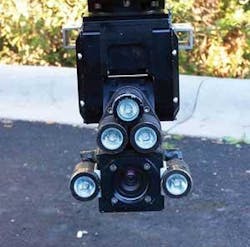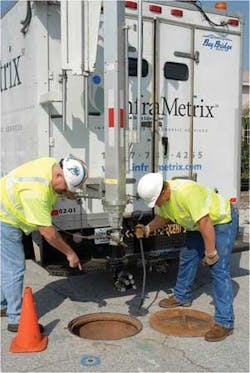By Paul J. Batman and James Shelton
In-line cameras (commonly referred to simply as CCTV) and zoom cameras are technologies commonly used for inspection of sanitary and storm water collection systems. Each has advantages and disadvantages with respect to cost, productivity, quality, data compilation, and ease of interpretation.
Malcolm Pirnie Inc. and Fairfax County, VA, devised an approach that combined zoom technology and traditional in-line camera technology to take advantage of the benefits of both to analyze the county’s sewer systems. This approach was tested in an 75 mile pilot program area (further separated into 11 project areas) as a precursor to developing a system-wide program to assess and rehabilitate the county’s storm sewer system.
Fairfax County covers roughly 400 square miles and is home to more than a million residents. It has a storm sewer system that has approximately 150,000 storm structures, 300 miles of storm channels, and more than 2000 miles of pipe, with parts of it at least 100 years old. The first task of the pilot program was to conduct a physical condition assessment of storm sewers, storm structures, and open channels within the program area.
For this program, storm sewer inspection was approached using a complementary combination of in-line and zoom camera technologies instead of only the traditional sewer inspection using in-line technology. The result was a rapid screening process that reduced the amount of in-line inspection necessary, while providing detailed inspections where necessary. This eliminated unnecessary pipe cleaning by identifying those pipes with excess leaves, debris, grit, and gravel that would interfere with the operation of the CCTV crawlers or obstruct the view of the CCTV cameras.
The first step of pipe inspection was to use the much quicker (and hence less expensive) zoom inspections for the screening step. InfraMetrix, LLC inspected storm sewers in the pilot project area using its CUES-IMX zoom camera. The diagnostic video camera has a high-powered tele-objective zoom lens that can help gather detailed information about the condition of collection systems.
In addition to improved optics, the CUES/IMX unit has lighting which automatically adjusts to match the focal length of the camera thus greatly improving the distances which can be viewed. The camera is able to view at least 50 feet in 6-inch sewer segments and up to 350 feet for larger sewers. The camera can also perform a 360 degree video inspection of the inlet and manhole structures as it is raised or lowered into the structure. Both inlets and storm sewers were inspected from the surface without the need for confined space entry.
Another benefit of the zoom camera approach is that each storm sewer was inspected from both the upstream as well as the downstream end. This allowed two perspectives on any defects or obstructions (something not easily accomplished with in-line CCTV cameras). Sewers with serious defects, with curved lines, or requiring significant cleaning were identified based on a set of criteria established at the outset of the program. Malcolm Pirnie then tasked these sewer segments to in-line inspection contractors for cleaning and/or detailed inspection. For sewers with no obstructions or defects, no further investigation was performed. Typically, most sewer segments inspected with the zoom camera did not have a significant defect or did not require any cleaning.
The in-line contractors, Hydromax USA and Video Pipe Services, inspected the critical sewer segments identified by the zoom camera. About half of the pipes that were inspected via CCTV required cleaning. In-line inspections use a television camera mounted on a remote controlled, self-propelled tractor that is connected to a video monitor and computer typically located in a van. The camera and tractor are remotely controlled from the surface by a qualified technician having PACP training and certification.
The camera mounted on the tractor advances through the sewer while recording a video of the inside of the sewer. When defects are observed, forward movement is paused and camera unit uses the pan and tilt mechanism to bring the defect under closer observation while the video recording continues. Defects are recorded into the computer system and place a description onto the recorded video and into a digital database.
Using the data provided by the zoom camera and in-line camera inspections, a review of the physical condition assessment was conducted by Malcolm Pirnie engineers and a rehabilitation approach was proposed for each asset within each project area.
Results
The goal of the combined approach was to evaluate the potential for cost savings while maintaining the same usefulness of the data collected. Data analysis was performed in the 11 project areas in the pilot study. Sewer inspection was conducted using solely in-line inspections for four of the 11 project areas, while the combined approach was used in the remaining seven areas.
For the seven areas that used the combined approach, approximately 62% of the sewer segments were first inspected using the zoom camera. A higher percentage could not be achieved because the storm system had so many buried inlet and manhole structures. The 38% that could not be zoomed was subsequently inspected by CCTV after the structures were located and uncovered.
Of those segments screened with the zoom technology, in-line inspection was warranted for only 36% of the segments. Overall, 62% of the segments were inspected with zoom technology, and 60% was inspected with in-line technology.
Cost Analysis
The cost difference between the in-line inspection method and the hybrid combination method for this program was evaluated. When in-line inspection required pre-cleaning prior to inspection, the associated pre-cleaning costs were incorporated into the in-line inspection costs. Cleaning is not required for the zoom technology method. The average total cost per linear foot was estimated for project areas that used both the hybrid combination technology as well as the stand alone in-line method of inspection. Cost results are presented in Table 1.
For the areas that used only the in-line method for sewer inspection, the average cost per linear foot was $4.90. On the other hand, for areas that used the hybrid combination method for sewer inspection, the average cost per linear foot was $3.30, translating into an average dollar savings of approximately 32% compared to the sewer inspections using the in-line method alone. In terms of the total project cost, this accounted to a cost saving of approximately a half million dollars.
By excluding cleaning costs associated with the in-line method, the average cost per linear foot of in-line inspection was $3.51 while the average cost per linear foot using the hybrid combination method amounted to $3.03, translating into an average savings of approximately 14% compared to the sewer inspections using the in-line method alone. In terms of the total project cost, this equaled a cost saving of approximately $200,000.
The combination approach was instituted for this program in order to reduce the cost of pipe inspections. As the results indicate, using this approach was indeed a cost saving initiative when compared to the in-line inspections alone. When implementing such an approach, it is important to understand the limitations and advantages of each technology and use both to their strengths. It is also important to consider in advance how the data will be used and set proper expectations for the results. A blend of zoom camera and in-line camera inspections was recommended for the storm sewer program moving forward. WW
About the Authors:
Paul Batman holds a Masters of Science degree in Environmental Engineering. He has worked for Malcolm Pirnie Inc., Wilmington, DE, for nine years on various collection system, distribution system, and water treatment projects. Most recently he has been assistant program manager or project manager for various projects under two major systematic sewer assessment and rehabilitation programs. Jim Shelton, PE, is Malcolm Pirnie’s National Practice Leader for the Buried Infrastructure Resource Team. He has served as project engineer, project manager, or program manager for sewer infrastructure investigation and rehabilitation efforts for more than 2,000 miles of sewer projects throughout Pennsylvania, Delaware, Maryland, Ohio, Virginia, Florida, North Carolina, and New Jersey.
Circle No. 214 on Reader Service Card





